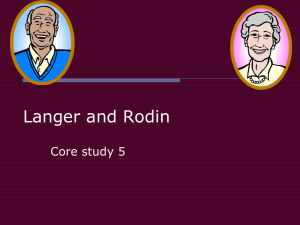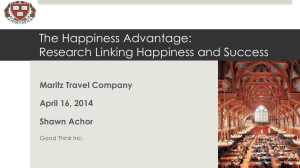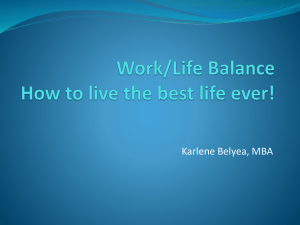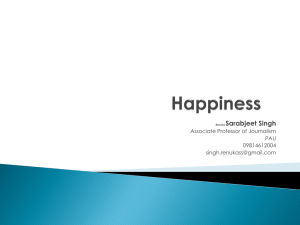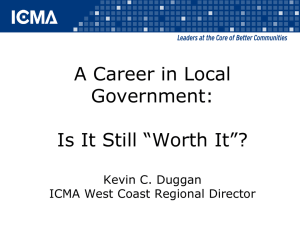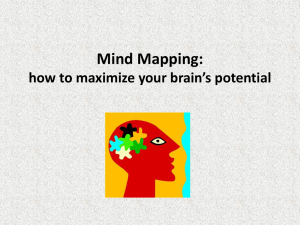Achieving Greater Success & Happiness
advertisement
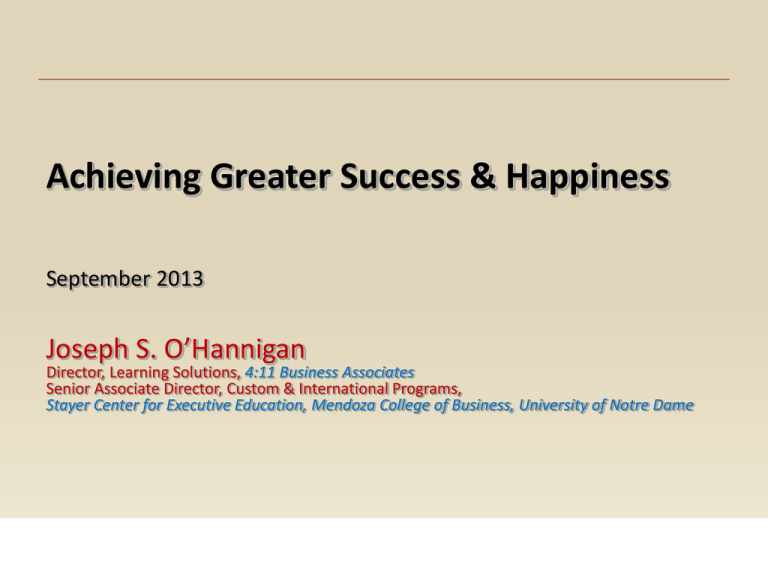
Achieving Greater Success & Happiness September 2013 Joseph S. O’Hannigan Director, Learning Solutions, 4:11 Business Associates Senior Associate Director, Custom & International Programs, Stayer Center for Executive Education, Mendoza College of Business, University of Notre Dame Agenda Sunday afternoon • Success • • • • • • & Happiness The small stuff Thriving spirits are capable and happy What if I’m not there, yet? The people (human connections) Psychological/ neurological foundations Understand and embrace the “stage” in which you find yourself • How is this connected? • Connections between happiness, creativity, productivity, and success • Now what?” Additional Application General ideas about happiness Happiness may flow from: Living with purpose and mission Becoming the best version of yourself (realizing your potential) Feeling capable Adding value, and knowing that you are making a difference Recognizing what’s important What people crave What we fear ©Charles M Schultz What makes you happier? Much of the research (of the last 20 years) confirms things we’ve always suspected. For example, in general, People who are in good romantic relationships are happier than those who aren’t. Healthy people are happier than sick people. People who participate in their churches are happier than those who don’t. Rich people are happier than poor people. (Source: The Science Behind The Smile, Daniel Gilbert, Harvard Business Review, January-February 2012) What was an unexpected discovery? …while all these things do make people happier, it’s astonishing how little any one of them matters …people are not very good at predicting what will make them happy and how long that happiness will last (Source: The Science Behind The Smile, Daniel Gilbert, Harvard Business Review, January-February 2012) It’s the little things The psychologist Ed Diener has a finding I really like. He essentially shows that the frequency of your positive experiences is a much better predictor of your happiness than is the intensity of your positive experiences… Somebody who has a dozen mildly nice things happen each day is likely to be happier that somebody who has a single truly amazing thing happen. (Source: The Science Behind The Smile, Daniel Gilbert, Harvard Business Review, January-February 2012) It’s the little things (continued) So wear comfortable shoes give your wife a big kiss sneak a french fry It sounds like small stuff, and it is. But the small stuff matters. (Source: The Science Behind The Smile, Daniel Gilbert, Harvard Business Review, January-February 2012) Rapid Exercise What are five “little things” you do, or could do? Three minutes individually, then three minutes to share in pairs “What does this have to do with creativity & innovation?” By and large, happy people are more creative and more productive We know that people are happiest when they are appropriately challenged when they are trying to achieve goals that are difficult but not out of reach. Challenge and threat are not the same thing. People blossom when challenged and wither when threatened. …no data showing that anxious, fearful employees are more creative or productive. (Source: The Science Behind The Smile, Daniel Gilbert, Harvard Business Review, January-February 2012) Thriving: Take One What makes sustainable individual and organizational performance? Thriving. …in which employees are not just satisfied and productive, but also engaged in creating their future—the company’s & their own. • 16% better overall performance • 125% less burnout • 46% more satisfied with their jobs (Source: Creating Sustainable Performance, Gretchen Spreitzer & Christine Porath, Harvard Business Review, January-February 2012) Thriving: Take Two …happiness on the job may depend more on our moment-to-moment experiences • our routine interactions with coworkers, • the projects we’re involved in, • our daily contributions, than on the stable conditions thought to promote happiness, such as a high salary or a prestigious title. (Source: Creating Sustainable Performance, Gretchen Spreitzer & Christine Porath, Harvard Business Review, January-February 2012) Thriving: Take Three • Happy employees produce more than unhappy ones over the long term. • They routinely show-up at work, • they’re less likely to quit, • they go above and beyond the call of duty, • they attract people who are just as committed to the job. (Source: Creating Sustainable Performance, Gretchen Spreitzer & Christine Porath, Harvard Business Review, January-February 2012) Two components of thriving: Vitality and Learning Vitality: the sense of being alive, passionate, and excited. Employees who experience vitality spark energy in themselves and others. Companies generate vitality by giving people the sense that what they do on a daily basis makes a difference. (Source: Creating Sustainable Performance, Gretchen Spreitzer & Christine Porath, Harvard Business Review, January-February 2012) Two components of thriving: Vitality and Learning Learning: the growth that comes from gaining new knowledge and skills. ~~~ Key take-aways about Vitality & Learning: The two qualities work in concert; one without the other is unlikely to be sustainable and may even damage performance Creativity and innovation might fuel both! (Source: Creating Sustainable Performance, Gretchen Spreitzer & Christine Porath, Harvard Business Review, January-February 2012) Two components of thriving: Vitality and Learning Individual strategies for thriving: Take a break Craft your own work to be more meaningful Look for opportunities to innovate and to learn Invest in relationships that energize you Recognize that thriving can spill over outside the office (Source: Creating Sustainable Performance, Gretchen Spreitzer & Christine Porath, Harvard Business Review, January-February 2012) Rapid Exercise 1. What strategy do you use, or want to use? 2. What are three practical (little) things you can do to advance that strategy, in the week ahead? Three minutes individually, then five minutes to share in pairs Can you change your happiness, your performance, your state? You Bet! • the habits you cultivate • the way you interact with coworkers • how you think about stress (Source: Positive Intelligence, Shawn Achor, Harvard Business Review, January-February 2012) Simple. Disciplined. Powerful. What can they (you) do to improve the happiness? • Gratitude: Jot down three things • Positivity: Write a message to someone in their social support network • Meditate: at their desk for two minutes • Exercise: for 10 minutes • Meaning: Take two minutes to journal the most meaningful experience of the last day (Source: Positive Intelligence, Shawn Achor, Harvard Business Review, January-February 2012) Thoughts. Actions. Habits. The biggest key to happiness? • Your “peeps” • Social support network • Your circle(s) (Source: The Science Behind The Smile, Daniel Gilbert, Harvard Business Review, January-February 2012) The biggest key to happiness (continued) If I had to summarize all the scientific literature on the causes of human happiness in one word, that would be “social.” If I wanted to predict your happiness… I’d want to know about your social network—about your friends and family and the strength of your bonds with them. (Source: The Science Behind The Smile, Daniel Gilbert, Harvard Business Review, January-February 2012) The biggest key to happiness (continued) Strong social support correlates with an astonishing number of desirable outcomes. …Social support was the greatest predictor of happiness during periods of high stress Received Provided (Source: Positive Intelligence, Shawn Achor, Harvard Business Review, January-February 2012) Get the right circles of support 1. Inner circle: spouse 2. Middle circle: friends & family 3. Outer circle: fellow travelers (Source: Start, Punch Fear in the Face, Escape Average, Do Work that Matters; John Acuff, 2013 Rapid Exercise Assessing my “circles:” 1. Well defined? 2. Appropriately populated? Any I should shift? 3. Where am I, in others’ circles? Five minutes individually, then five minutes to share in pairs Deeper into the Psychology & Neuroscience What and how we decide Within less than a second… people make what are called “spontaneous trait inferences…” how people perceive and categorize others (friend or foe)… warmth and competence… accounts for 80% of our overall evaluation of people (Source: Dr. Amy Cuddy, quoted in “The Psyche on Automatic,” by Craig Lambert, Harvard Magazine, November-December 2010) Warmth & Competence First and most important: does this person feel warm or cold to me? Then competence: how capable is this individual of carrying out their intentions? (Source: Dr. Amy Cuddy, quoted in “The Psyche on Automatic,” by Craig Lambert, Harvard Magazine, NovemberDecember 2010) Competence Competence is perceived to indicate ability • one demonstrated example/behavior is quickly generalized to wider competence • one negative example (incompetence) is NOT generalized, but excused • We like (want) to be perceived as competent… first and foremost! (Source: Dr. Amy Cuddy, quoted in “The Psyche on Automatic,” by Craig Lambert, Harvard Magazine, November-December 2010) Warmth Warmth is perceived to indicate character • one nice gesture is NOT generalized to suggest the actor is warm • one ugly gesture (kick the dog) is quickly generalized to indicate COLD • We judge others, first and foremost, as warm or cold (Source: Dr. Amy Cuddy, quoted in “The Psyche on Automatic,” by Craig Lambert, Harvard Magazine, NovemberDecember 2010) Rapid Exercise How others view you; have the people around you tell you: 1. What’s a signal (verbal or non) that helps indicate your competence? 2. What’s a signal (verbal or non) that helps indicate your warmth? Now you tell them: What’s a signal (behavior or habit) that I want to give to the world, to express my competence or warmth? Twenty minutes as a small group, 5 max per group Warmth & Competence Underneath our emotional/ intellectual reactions: (Source: Dr. Amy Cuddy, quoted in “The Psyche on Automatic,” by Craig Lambert, Harvard Magazine, NovemberDecember 2010) Perceptions of Warmth & Competence Nonverbal cues drive our perceptions; dominance and power are perceived as competence High testosterone (power and dominance hormone) Low cortisol (the stress hormone) Posture: Expansive, open vs. Contracting, minimizing Two minutes of high- or low-power poses, before challenging task produces a dramatic change in testosterone and cortisol (Source: Dr. Amy Cuddy, quoted in “The Psyche on Automatic,” by Craig Lambert, Harvard Magazine, NovemberDecember 2010) A simple, powerful acronym from Neuroleadership SCARF Enhances happiness or fear (Source: SCARF: A brain-based model for collaborating with and influencing others; David Rock SCARF 1. Much of our motivation driving social behavior: minimizing threat(s) maximizing reward(s) 2. Social experience (behavior) draws upon the same brain networks used in survival So we have a threat response, or an affinity response (Source: SCARF: A brain-based model for collaborating with and influencing others; David Rock SCARF Status: our relative importance to others; status threat is a desire to not be perceived as less than another • Performance reviews; “can I offer you some feedback?” • If a leader wants to change others’ behavior, reduce status threats when giving feedback • Status can go up with positive feedback, public acknowledgement (Source: SCARF: A brain-based model for collaborating with and influencing others; David Rock C S ARF Certainty: ability to predict the future; our brains are pattern recognition machines; we want to reduce uncertainty • Large uncertainty can be debilitating • Remedies: as much clarity as is possible break down complex projects to simple steps establish clear expectations (Source: SCARF: A brain-based model for collaborating with and influencing others; David Rock ARF SC Autonomy: a sense of control over events • Strong correlations between a sense of control and health outcomes • Micro managed? Strong threat response (Source: SCARF: A brain-based model for collaborating with and influencing others; David Rock R SCA F Relatedness: sense of safety with others; “in” or “out” of a social group • Oxytocin hormone associated with affiliative behavior; • A handshake, swapping names, finding common ground… all increase a sense of closeness (Source: SCARF: A brain-based model for collaborating with and influencing others; David Rock F SCAR Fairness: perception of fair exchanges between people • Unfair exchanges? Experienced or observed, a strong threat response • Reduce unfairness perception with more transparency, clear expectations (Source: SCARF: A brain-based model for collaborating with and influencing others; David Rock Rapid Exercise With respect to SCARF: 1. Where do you feel strong? 2. Where do you feel weak? 3. With whom might I discuss this for support and suggestions? Five minutes individually Out of Psychology & Neuroscience, Back to Behavior Another key: recognize & embrace your “stage” Want to feel happy, “awesome?” Achieve “awesomeness?” Recognize and embrace “where you are:” 1. 2. 3. 4. 5. Learning Editing Mastering Harvesting Guiding (Source: Start, Punch Fear in the Face, Escape Average, Do Work that Matters; John Acuff, 2013 Stages can be chronological 1. 2. 3. 4. 5. Learning Editing Mastering Harvesting Guiding In your 20s 30s 40s 50s 60s+ (Source: Start, Punch Fear in the Face, Escape Average, Do Work that Matters; John Acuff, 2013 Stages can be situational 1. 2. 3. 4. 5. Learning Editing Mastering Harvesting Guiding … Every time starting a new project; chasing a new passion (Source: Start, Punch Fear in the Face, Escape Average, Do Work that Matters; John Acuff, 2013 Average (behavior) vs. Awesome “Average” is easy, and will not produce the greatest happiness. “Awesome” takes focus and dedication, but is so worth the resulting joy… (Source: Start, Punch Fear in the Face, Escape Average, Do Work that Matters; John Acuff, 2013 Short Cuts? Not really. But you CAN: • • • • Start earlier Stand on the shoulders of giants Work harder and smarter Harvest someone else’s fields (Source: Start, Punch Fear in the Face, Escape Average, Do Work that Matters; John Acuff, 2013 Stages 1. Learning … Experiment … Creativity & Innovation (Source: Start, Punch Fear in the Face, Escape Average, Do Work that Matters; John Acuff, 2013 Stages 2. Editing … What gives me the most joy? … Value Attribution: you get to decide what’s a diamond, and what’s a rock … Intentions are ambitious liars … What feels “good?” “great?” “awesome?!” (Source: Start, Punch Fear in the Face, Escape Average, Do Work that Matters; John Acuff, 2013 Stages 3. Mastering … Are you willing to fight for your passion? “It’s time to throw some elbows” …Get experience (anywhere, with anyone) …Do not promote yourself too much, yet … “Haters” are inevitable *Who said it? *Why did they say it? … build your own “Central Park” (Source: Start, Punch Fear in the Face, Escape Average, Do Work that Matters; John Acuff, 2013 Stages 4. Harvesting … How to be awesome… [in] just about everything you do? … don’t be a jerk (Source: Start, Punch Fear in the Face, Escape Average, Do Work that Matters; John Acuff, 2013 Stages 5. Guiding (others) … Seek clarity; be clear … Start with “why?” (Source: Start, Punch Fear in the Face, Escape Average, Do Work that Matters; John Acuff, 2013 Average (behavior) vs. Awesome You will work harder at something you love than something you like; You will work harder than you have ever worked when you start chasing a dream; You will hustle and grind and sweat and push and pull; You will get up earlier and go to bed later. But that’s ok, joy is an incredible alarm clock. (Source: Start, Punch Fear in the Face, Escape Average, Do Work that Matters; John Acuff, 2013 Agenda Revisited • Success & Happiness • The small stuff • Thriving spirits are capable and happy • What if I’m not there, yet? • The people (human connections) • Psychological/ neurological foundations • Understand and embrace the “stage” in which you find yourself Do you see… … Connections between happiness, creativity, productivity, and success? Decision/ Application time 4:11 Business Associates On the way of wisdom I direct you, I lead you on straight paths. When you walk your step will not be impeded, And should you run, you will not stumble. Hold fast to instruction, never let it go; Keep it, for it is your life. Proverbs 4: 11- 13 johannig@nd.edu
